The Yuck Factor: Why We Find Things So Disgusting
We delve into the disgusting to discover the emotion of disgust and how it affects our lives. From cockroaches dipped in juice to the importance of sanitation, no topic is off limits as we find out about the psychology of this most powerful of emotions and its applications. Plus, in the news, a universal flu therapy, why zebras have stripes, and the robot that can jump on water.
In this episode
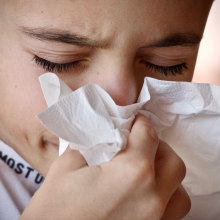
00:51 - One drug to prevent all forms of 'flu
One drug to prevent all forms of 'flu
with Dr Jacob Yount, Ohio State University
Worldwide, the flu kills up to half a million people every year. One of the main ways of preventing the disease is vaccination, but because the influenza virus is constantly changing or mutating, vaccine-makers are always playing catch-up. Now scientists may have a new way to fight the flu using a treatment that can prevent infection with any strain of the virus. Jacob Yount, from Ohio State University, has discovered how to boost the activity of a substance made naturally by our cells, called IFITM3, which has a powerful flu-blocking effect, as he explained to Chris Smith...
Jacob - What we've discovered is a way to enhance a natural antiviral defence mechanism in cells that is active against influenza virus. This involves a protein called IFITM3 (interferon inducible transmembrane 3). What IFITM3 does is it blocks the ability of influenza to enter cells. This is really a very ancient or primitive defence mechanism. It's present in some single-celled organisms and this is completely independent of vaccines or the antibody response that we're associating with vaccines.
Chris - What does that IFITM3 protein normally do on the surface of the cell then to block flu and stop it in its tracks?
Jacob - Exactly how IFITM3 is able to prevent the virus fusing with the cell is not entirely clear, but what we do know is that when cells make a lot of IFITM3, it becomes very difficult for the virus to infect cells.
Chris - Well, that begs the obvious question then, why don't cells make lots of it all the time?
Jacob - It's not entirely obvious why they don't make a lot of it, but what we know is that they don't keep it around until there's a virus present. So, once there is a virus infection then the cells, the body stars making a lot of IFITM3. And so, what that does is it limits the spread of the infection.
Chris - By literally stopping the flu getting into any new victim cells so it can't increase its numbers any further.
Jacob - Yes, exactly. So, we've been looking for at least a few years now for different ways to be able to get cells to express or make a lot of IFITM3 in the beginning before a virus infection is present.
Chris - Right. So the idea would be, it's almost like putting the cells into defensive mode so they're already capable of warding off virus before it even arrives and then when some virus does come on the scene, it just can't get in.
Jacob - Yes, exactly. So, we've known for a long time that if we can get cells to express or make a lot of IFITM3, they're very resistant to flu infection right from the start.
Chris - How does one go about doing that then? How can you boost the amount of this IFITM3 signal?
Jacob - So, what we found is that one of the reasons that IFITM3 levels are so low is that the cells mark IFITM3 to be degraded. This involves another enzyme called NEDD4. Now, when we deplete cells of NEDD4 then we see that IFITM3 is able to accumulate even in the absence of infection.
Chris - So, it's a bit like the cell adds a 'best before date' like supermarkets do, to the IFITM3 and the cell comes along says, "Right. Your time is up" and hoiks it off. What you're doing is effectively removing the shelf stacker who would normally go around in the supermarket removing the stuff that's over its 'best before date' so the protein stays there on the cell surface, doing its job for longer so you get a more pronounced effect.
Jacob - That's exactly right. We found a way to extend the half-life of IFITM3 by eliminating the protein NEDD4.
Chris - What would be the implication then? If you're successful and you can make a drug that will do this in a human being, what would be the implication? Why is this an important discovery?
Jacob - So, what IFITM3 does is it really inhibits all strains of the flu that we've ever tested. So in that way, it would be protective against even new and emerging strains of flu.
Chris - And that means that the eternal search for the next vaccine which the World Health Organisation spends a fortune doing every year, and occasionally gets wrong like it did last year in some respects, that wouldn't matter anymore because we wouldn't need to keep making new flu vaccines. We could just give people this agent that you're going to invent instead.
Jacob - Right. So, I think that this would definitely be a complimentary strategy to vaccination especially if there was a new virus that emerges that we haven't yet developed a vaccine for.
Chris - So we're probably a little bit early for next flu season so we shouldn't hold our breath there, but there's certainly hope. Will it work against other viruses or is this an anti-flu effect exclusively? I'm thinking of, have you actually got the cure for the common cold here too?
Jacob - That's actually a really good question. IFITM3 does inhibit other viruses. It inhibits viruses that enter cells in a similar way to flu. And some of those viruses are things like dengue virus, west Nile virus, and even Ebola virus.
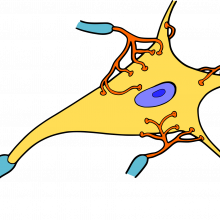
05:58 - Scientists re-grow damaged nerves
Scientists re-grow damaged nerves
with Prof Alison Lloyd, University College London
Thanks to the dexterity of surgeons, it's possible to reattach severed fingers, toes and even limbs - and what's even more amazing is that the peripheral nerve cells, or neurons, can rewire themselves back into the damaged tissue, bringing back sensation and movement. But how do they do it? UCL's Alison Lloyd has been studying how these neurons, along with special helpers called Schwann cells, manage this impressive feat, as she explained to Kat Arney...
Alison - Imagine that your nerve is completely severed. The connections to the nerve, if you could think of it like an electrical cable with lots of separate wires within it, attaching to various points, downstream of that cut, all of the wires will disintegrate. Then what has to happen is those wires or those neurons have to regrow back to their targets and that's the repair process. This is much more tricky than it sounds but it's joined up by this sort of mush of inflammatory cells and matrix which joins together the ends of this severed nerve.
Kat - Sort of biological gluey stuff.
Alison - Exactly. It's very non-directional and it's very dense, full of matrix and other cells. What we've shown previously is that a special cell type within the nerve which are called Schwann cells, they are able to migrate out of the stumps across the bridge and they migrate as cords across the bridge taking the axons with them. They are then able to grow down back to their targets. So, what the mystery was, what we didn't understand is, this is quite a big gap. This is quite a big bridge. There was no directionality to it. We couldn't understand how these cords knew where to go. What we found was that there was another cell type that was very important in this process. These are endothelial cells and these are the cells that make blood vessels. So, what was happening first was that this mush had cells in it which were sensing that they weren't getting enough oxygen, what happens in response to loss of oxygen that there are signals that make blood vessels grow.
Kat - What do your results show might be going on when nerve cells are growing across this gap to repair the damage?
Alison - What we found is that the Schwann cells are only able to migrate along the surface of another cell type. In this case, it's the blood vessels. So, the first thing that happens within this bridge is that there's a lack of oxygen which is sensed by inflammatory cells. They send out a signal which causes the formation of blood vessels. The Schwann cells can't migrate within this matrix. They need this surface of the blood vessel. The blood vessels grow as tracks. They're polarised in the direction of travel and the Schwann cells use this to find their way across the bridge.
Kat - So, it's kind of like a train can only run on a track. Yeah. Once it gets going, it's great but it has to have that track there first.
Alison - Yes. So the Schwann cells seem to have this engine that can make this forceful migration, but they need a specific track in order to migrate and that's different to other cells.
Kat - How can we use this knowledge to, for example, get better at repairing nerves?
Alison - We have surgeons who tend to sew up the gaps, but even so, for serious injuries, there's often a gap in the nerves. And so, people try and make artificial bridges to encourage this nerve growth. And that's a big problem area in that, sometimes the gap is quite big and then you have these different artificial bridges that people try and use to encourage the neurons to regrow across this bridge area. And so, I think what our work suggests is that what you want to do is to mimic the real bridge. So, you want to maybe make tubes with blood vessels, either blood vessels themselves or surfaces that mimic what it is about blood vessels that provide a surface for the Schwann cells. But I think it has broader implications for other diseases as well. The way that certain cancers spread within the body, these cells are moving along the surface of other cells. It has been observed that cells such as melanomas and gliomas for example.
Kat - Those are brain tumours.
Alison - They're brain tumours and they're very, very invasive. That's the major problem with them but they also seem to be migrating along the surface of blood vessels. So, it's possible that when these cancer cells are moving and they're moving along blood vessels, they're using the same mechanisms that you see following an injury and they're co-opting this type of behaviour in order to spread. And so again, if we can understand that better then possibly, we can understand better how tumours spread and then maybe do something about it.

10:33 - The secrets of stalagmites revealed
The secrets of stalagmites revealed
with Dr Sebastian Breitenbach, University of Cambridge
Cave deposits, known as stalagmites, provide a valuable insight into how climate has  changed in the past. Their isotopic composition - essentially variations in their elemental makeup - can inform us that a major climate event took place. However, the effect that climate events had on society is somewhat more difficult to unravel. A team of scientists have discovered a unique cave in central China that contains both stalagmites and dated inscriptions describing the effects that severe droughts had on the local population. Joanna Kerr spoke to Sebastian Breitenbach to learn more about reconstructing changes in climate that happened hundreds of years ago.
changed in the past. Their isotopic composition - essentially variations in their elemental makeup - can inform us that a major climate event took place. However, the effect that climate events had on society is somewhat more difficult to unravel. A team of scientists have discovered a unique cave in central China that contains both stalagmites and dated inscriptions describing the effects that severe droughts had on the local population. Joanna Kerr spoke to Sebastian Breitenbach to learn more about reconstructing changes in climate that happened hundreds of years ago.
Sebastian - We go into the cave and we try to find stalagmites that are growing very simple. We cut them open and then we can already see these layers - brown, sometimes they're translucent, and sometimes these layers are annual. We can either count these layers to get the chronology or we can take uranium series samples and date them precisely, and then we can take like a small drill, like a dentist drill. You can take small samples and measure the isotopes or elemental concentration.
Johanna - How do the isotopes in the stalagmite tell us about the climate?
Sebastian - For example, if you look at the oxygen isotope ratios, they are dependent on the oxygen ratios in the rainfall and in the water that infiltrates into the cave. They would be more negative when there's a strong monsoon and they would be more positive when there's less strong or big monsoon. However, this is always ambiguities because there are other factors that also influence oxygen like temperature changes. The exceptional thing in this cave is that we have these inscriptions and we can compare extreme events for example with much higher, that are routine values, compare them to the inscriptions and we actually find that the inscriptions that we have, the timing of these inscriptions fits very well with these extreme events.
Johanna - Why were people entering the cave and why do you think that they chose to write about these climate events.
Sebastian - They would go to the cave because the cave holds water for longer. Even if you have above the cave already dry conditions, the cave would still have some time when it was dripping. In the cave, you have a lake, you have a lot of water flowing around, and people went there firstly to collect water. Certainly, the local farmers knew about this cave for forever already. But then if this is the last wet place in the surrounding then people would go there and pray. From what we know from these inscriptions is that the governor for example came to the place. So, they have one inscription. The governor of the Ningqiang district came to the cave to pray for rain. That's inscribed as a graffiti in the cave, on the wall.
Johanna - In these inscriptions, did the people provide any information about how they reacted to the droughts or how the communities reacted to the droughts?
Sebastian - Not in great detail. The inscriptions are quite short. We know from historic record that these times were associated with civil unrests, even with cannibalism, the people migrating from one place to another in search for water.
Johanna - Do you think that there are any lessons to learn in terms of how the population reacted to these droughts and to climate change and how we may react as a population in the future?
Sebastian - So there are two important things that we should bear in mind. One is that a reconstruction that we have from this cave tells us that even relatively short but very intense droughts can have a very severe impact on human and on society in the region. Of course, we cannot directly compare what happened 500 years ago with what's going on right now because nowadays, civilisation is much advanced and it's industrialised. But if you just think about the drought in California, even there, there's now a huge drought and people start moving away and digging deeper wells to reach the groundwater. So, the society at large is still vulnerable to such events. The other thing that is important to keep in mind is that when we compare the geochemical evidence with model output then we see an increasing likelihood of drought events and more frequent extreme events. Meaning, we might get more flood events during the monsoon and we can also think of a longer dry period. So, each winter might be or dry season might be longer than before and that would be disastrous for the farmers.
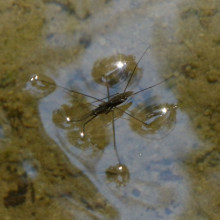
15:44 - Robots that jump on water
Robots that jump on water
with Victoria Gill, BBC News
Scientists have developed a tiny robot - based on the pond skater or water strider 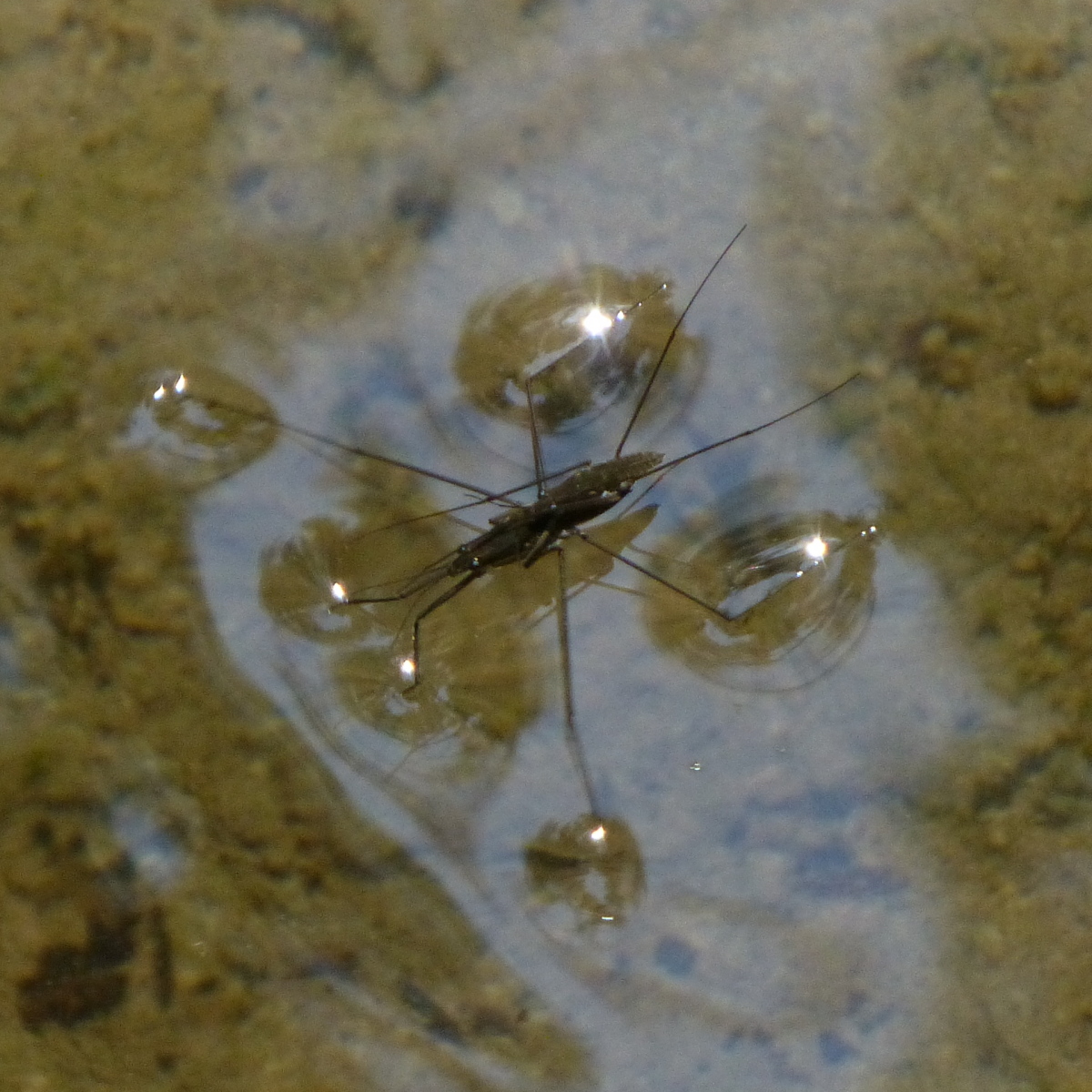 insect - which can jump on water. Four thin wire legs extend from a vee-shaped central "body" of the robot and allow it to sit on the water surface. Across the apex of the vee is a spring system, which works like a catapult, releasing energy to bend the vee-shape and push the legs down against the water, propelling the robot off the surface, exactly as the real insect does it. Science reporter Victoria Gill talked Chris Smith through the story...
insect - which can jump on water. Four thin wire legs extend from a vee-shaped central "body" of the robot and allow it to sit on the water surface. Across the apex of the vee is a spring system, which works like a catapult, releasing energy to bend the vee-shape and push the legs down against the water, propelling the robot off the surface, exactly as the real insect does it. Science reporter Victoria Gill talked Chris Smith through the story...
Victoria - This is a new robot which jumps on water. This is researchers from Seoul National University in South Korea and they have taken water striders, literally collected them from a local pond and they've been studying them with high speed cameras and looking at the mechanism by which they jump because water striders are unique in that they can jump from the surface of water without breaking that water surface. So, these researchers wanted to find out how and then create a robot that copied that mechanism, and that's what they've done.
Chris - Before we come on to how they actually do it, why is this important? Why do we need to know how they do this?
Victoria - There's a lot of interest in getting robotics into situations where we wouldn't be able to get ourselves whether that's miniaturisation or whether that's moving through and across surfaces, and dangerous places that we wouldn't be able to access. Obviously, there's military applications for that, but these researchers really wanted to drill down into how this biology works so they could apply it to bio-robotics. They suggest that there might be surveillance for environmental purposes. If you're looking at working in watery surfaces and there's also search and rescue applications.
Chris - So, what did the videos reveal? How do these insects do this?
Victoria - What they were looking at is water strider's skinny little legs and how they make contact with the water. But then how they move their legs as they press down with a downward force and you get an opposite upward force, pushing them off the surface of the water. While most jumping insects apply a high force very quickly, the maximum force is that initial push off of the ground. If you do that on water, you break the surface tension of the water. So, you can't truly jump off the surface.
Chris - And you would sink of course.
Victoria - And you would sink, exactly and there are some jumping insects that sort of compromise their jumping abilities when they're on water by utilising the viscosity of water and having very, very light bodies and being structured in a particular way so that they can utilise that and still get some sort of jump. But water striders can jump just as well off the surface of water as they can on land and that's all about how they jump. So the crucial thing is to apply a force gradually that never exceeds the force that's holding those water molecules together. So, it never exceeds the surface tension of the water. That's what they saw in the water strider and what they've been able to copy. So, it's a jumping mechanism that gradually applies a force and the force never exceeds the surface tension of the water.
Chris - So now we know what we've got to achieve with the robot, but looking at the insect for a minute, do they have any idea how they achieved that graded force like that so they don't penetrate the surface of the water?
Victoria - Essentially, what they use is called the 'torque reversal catapult'. That's the mechanism. Now, this is essentially a spring and this was first seen in flea legs - fleas being these incredible jumpers that actually, biologists and bio-roboticists are really interested in their incredible abilities to jump so high and so fast. What they do is ratchet up kinetic energy stored in a spring and that sort of torque moving in one direction. You can imagine that spring then moving through, rotating around that joint and then suddenly, all the torque is moving in the other direction. So, that's a sort of innate, in-built catapult that stores that kinetic energy and then releases it very, very quickly. But they tune that catapult in order to release that energy gradually and to never exceed the force of the surface tension of the water.
Chris - Does this mean then that we can do this, but we can only do it with very, very tiny robots or will it scale up to bigger things?
Victoria - I asked that actually and at the moment, it's purely miniaturisation and this has actually been a long process to build something that would be the right weight. They've had to use a very, very hydrophobic or water repelling material to be able to create these little skinny legs that don't break the water surface. So, there's been a lot of fine tune mechanics to create a light-bodied skinny legged insect robots. So at the moment, this couldn't be scaled up. The dynamics just wouldn't work in the same way.
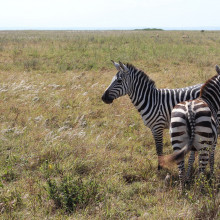
20:34 - Why the zebras got its stripes
Why the zebras got its stripes
with Anna Hughes, Cambridge University
While many animals use camouflage to try and blend into their environment in their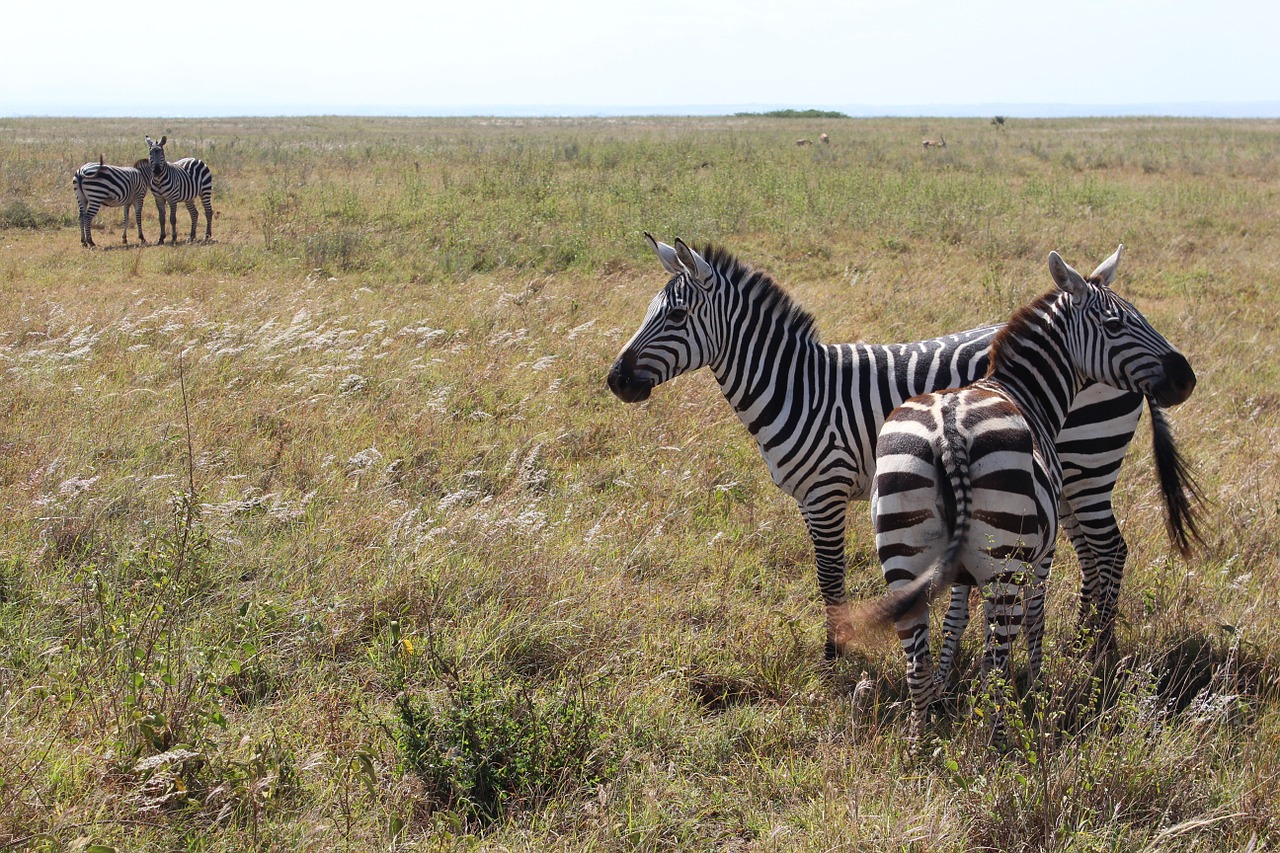 quest for survival, others employ a very different technique. Zebras are the primary example of animals using so-called 'dazzle patterns' to try and confuse their predators, the same idea that was behind the 'dazzle-ships' of WWI. However, 100 years after these boats were designed, new research has called into question just how effective their patterns really are. James Farr spoke to Anna Hughes from the University of Cambridge to find out more...
quest for survival, others employ a very different technique. Zebras are the primary example of animals using so-called 'dazzle patterns' to try and confuse their predators, the same idea that was behind the 'dazzle-ships' of WWI. However, 100 years after these boats were designed, new research has called into question just how effective their patterns really are. James Farr spoke to Anna Hughes from the University of Cambridge to find out more...
James - We've just come in to the University of Cambridge's Fitzwilliam Museum and we're being led through a sort of series of galleries, all with lots of old-looking pieces of art and sculptures on the walls. We've arrived at a study room in which we're going to view some special drawings I believe. We're here to see a couple of drawings by an artist called Norman Wilkinson who was famous for drawing the dazzle ships that were used in the First World War. They've got really strong black and white striking stripes which looked very much like zebras really.
Anna - Yeah. So, it was actually inspired by the natural world. It's been thought for a long time that the stripes of animals like zebras might act to confuse a viewer. It might make it hard to judge a speed or direction of them when they're moving. This is why these war ships were painted in this way, but it was not really ever tested at that time whether it worked. And so, recent researchers asked the question, does it? Is that why zebras have stripes? That's the idea of this hypothesis which is often called 'motion dazzle hypothesis' that the stripes are an anti-predator defence.
James - It's a very different style of camouflage to what people might think of as a traditional style, more like something that tries to blend in.
Anna - I think the key thing here that's different is, if you're not moving and you match your background perfectly, it is in fact very difficult to see you. But as soon as you start moving, it's much easier to see even if it's well matched to its background because it just sort of pops out from the background. So, it's interesting to know whether there are types of patterns that might not make it difficult to detect something when it's moving, but that make it difficult to aim at.
James - Your new paper sets out to test this idea and assess whether it really does work.
Anna - Yeah. We have been looking at whether this could be a plausible explanation for the evolution of zebra stripes and possibly, stripes in other animals as well. So, we conducted a study using humans as sort of model predators and what they have to do is they play a little game basically, a touchscreen game where they have to try and catch the moving targets. We tested different types of targets with different types of patterns and we were asking, do stripes - of the sort that you might see in a zebra - offer any benefit, over a uniform grey that in our experiment was very well traditionally camouflaged against the background? We found that when the targets are presented on their own so that participants just try to catch one target at a time, the striped targets and the grey targets were pretty similar. But when we looked at increasing the number of targets to a present study one time, surprisingly, we actually found that the stripes were actually easier to catch than the camouflage grey. So, it didn't seem to be that the stripes provided extra protection when there were more targets present.
James - So in actual fact, the stripes made it easier in some sense for their predators, actual humans playing the game to spot the targets.
Anna - Yeah, this is kind of quite surprising. I mean, it is always worth remembering with this sort of study is, an artificial set up in a lot of ways. Humans are not the natural predators of zebra and lions and other predators do have different visual systems. So it could be that this is partly an artefact of the way that we set up the game. It's also the case that we use quite a simple model of how the targets moved. So, they weren't particularly moving in a herd or moving kind of individually. It would be really cool I think to test more thoroughly what it would be like if you actually tried to get the targets to move with relation to each other because there, you might see stronger effects.
James - Are there any other areas you'd like to go down in the future to extend this research?
Anna - So, I think one of the cool things about this topic is that it's probably quite likely that there are multiple functions to the zebra stripes. And there's been a few recent papers that have suggested alternative hypothesis. So for example, there's been some suggestions recently that the stripes might not actually be deterring mammalian predators but are in fact maybe deterring flies. So, biting flies that kind of irritate the zebra and maybe transmit things like malaria. So, there may well be tests that can be done using flies to see if they're repulsed by stripes and whether that acts possibly in a sort of motion dazzle manner, making it difficult for them to land accurately or something like that. There's various hypothesis and I think it's probably not necessarily just one explanation but maybe several different things that have come together to create, really quite unique patterning in this animal.
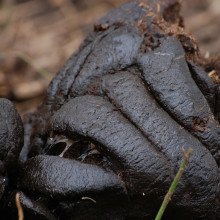
26:02 - What is disgust?
What is disgust?
with Professor Paul Rozin, University of Pennsylvania
Disgust. We have all experienced it- whether from treading on a slug in the dark or  realising you have just bitten into an apple crawling with worms. That creeping feeling of your skin, the rising nausea and the desire to distance yourself from whatever it is you have just seen or felt is familiar- you may even be experiencing it now from reading these descriptions. Ginny Smith asked Professor Paul Rozin, who was one of the first researchers to work on disgust, what exactly it is:
realising you have just bitten into an apple crawling with worms. That creeping feeling of your skin, the rising nausea and the desire to distance yourself from whatever it is you have just seen or felt is familiar- you may even be experiencing it now from reading these descriptions. Ginny Smith asked Professor Paul Rozin, who was one of the first researchers to work on disgust, what exactly it is:
Paul - Disgust is a basic emotion, but it actually means two things in English. One is, what the psychologist means, a particular type of negative emotion. But it's also used in English to mean bad. So, you might say anything is disgusting when you want to say it's bad and that produces a problem because when we ask people about disgust, there were both of these usages. Now, we have a word in English, 'gross' which actually means more like what psychologists mean by disgust.
Ginny - What kinds of things evoke that feeling of disgust or grossness?
Paul - The basic idea is the things that are offensive. But in a particular kind of way, the most clear-cut forms of disgust are to rotting things like animal flesh or certain kinds of dirty animals like rats, or dead bodies. But they're all very bodily and some people think that the basic core of that is a system to keep us from acquiring pathogens which are usually carried in animals and more so in decaying animals. But it's extended way beyond that in the way culture uses the term.
Ginny - So, let's go back a step. When we first evolved disgust, where do you think that came from?
Paul - Well, it's pretty clear with the system that it originated from. That's the bitter taste system which is then rats and primates. It's the negative response to bitter taste and the face that infants make to that which is an innate rejection is very similar to the disgust face. So, it looks like that system was co-opting or the term I use is 'pre-adapted', used for another purpose in the course of evolution. The system was already in place, it was a food rejection system, but now, a whole new class of things, that system became used for those. And actually, bitter taste were no longer disgusting. People don't use the term and they don't feel nausea which is the sign of disgust. So, the system was pre-adapted and co-opted from the bitter system, but it's now independent of it.
Ginny - So, that disgust face you mentioned, that's the kind of wrinkled nose, the gaping mouth, maybe even sticking your tongue out that if you think of something disgusting, you'll probably start doing.
Paul - There are a number of faces but they all have to do with rejection of stuff from the mouth and not smelling it. It's the raised upper lip is the most important piece of it, but it also includes the wrinkling of the nose and the gape. So, that system is used in response to all sorts of things which are primarily animal things that we reject. And then through the same process of co-optation or pre-adaptation, it becomes used for other things that are offensive but not having to do with the body. For example, strangers, people you don't like, negative figures like Hitler, and also, for all sorts of sexual things like incest.
Ginny - Now that's really interesting that it could've gone from being something that's physically to protect you against poisons or pathogens to - it's still protective in a way but in a more kind of indirect way. Is that quite unusual?
Paul - It's not unusual. It's a very common process in both biological and cultural evolution. That's something that evolved from one purpose that's used for another. For example, your mouth evolved to eat and breath, but it's used for language. So, the language system co-opted the mouth. You need your teeth and your tongue to speak, but they didn't evolve for that purpose. So, we are constantly re-using things and this is just one example. So, the big issue now is, how do you link the presumed pathogen origin of disgust which may have been biologically or culturally evolved, we don't know, but how do we get from that to other negative things? So, one is to talk about the fact that sexual activity also is a potential way of passing pathogens like sexually transmitted disease. That's one view. My own view with my colleagues, McCauley and Haidt is that that's not really what happened. That the culture discovered that if they can make something disgusting, people wouldn't do it. So, they have this disgust system and they just apply it to other things like incest or evil people which are not related to pathogens at all. They all have the property that we want to get rid of them, we won't want to deal with them.
Ginny - Now, you spent a lot of time studying disgust in the lab. What do you do to people to make them disgusted? What kind of experiments have you done?
Paul - Well first, let me just say, disgust is extremely easy to elicit in people in a laboratory setting, much more so than anger or sadness. But disgust is easy. All we have to do is take out of disgust the object. And we even have to take out an image of disgusting object.
Ginny - Even just talking about something disgusting, I know when I've been planning the show, there have been a few moments I've been talking to people and got that horrible cringing feeling just from talking about something. It's amazingly easy.
Paul - The most indirect thing is that something looks disgusting. But really is that people still show the response. So, we did this in the lab by presenting college students with a piece of chocolate shape to look like a dog doo. They do it with chocolate and there was a piece of the chocolate it was made from right there and most people didn't want to eat it even though they knew it was chocolate because it looked like dog doo. So, there's a powerful sense of disgust that way.
Ginny - You've done all the studies where you've looked at how disgust can get passed on from a disgusting object to another object as well, haven't you?
Paul - We give them a glass of juice that they know was good juice. We pour it out for them from the container and they drink it. And then we drop a cockroach in it. It's a dead cockroach and take it out. So, there's no sign of the cockroach and they won't touch that juice. They hated it. So, it's so powerful that when it touches something, it renders it inedible. Now, if we ask people, "Why didn't you drink the juice?" They'll say "because cockroaches are diseases vectors. You'll never what's in there. You can get something." So we say, "Okay, we'll do it again with a sterilised cockroach. This is a cockroach that is safer than your fork." We dropped that and take it out and they won't drink it because as it plays out now, though it may have originated as a pathogen, it's the whole idea that cockroach-ness entered the juice. When a cockroach touches your juice, its essence passes into the juice and it doesn't matter whether it's carrying microorganisms or not. Hitler's sweater which is a thing that we don't own but we use it in describing it. It's something that people are really offended by. They won't wear Hitler's sweater even if you'll wash it and do everything you can to it. It isn't the pathogen threat. It's a moral threat. So, that's how disgust is expanded from being just about potential bad consequences of eating to be - it's a sign of immorality and it's a way of labelling them and getting other people to avoid them.

36:25 - Men are less easily disgusted than women
Men are less easily disgusted than women
with Dr Alex Skolnick, St Joseph’s University Philadelphia
Some people have their stomach turned by just the mention of something  disgusting, while others can happily eat their dinner while talking about toilets. Alex Skolnick is from St Joseph's University Philadelphia, and he explained to Kat Arney why some of us are far more disgustable than others.
disgusting, while others can happily eat their dinner while talking about toilets. Alex Skolnick is from St Joseph's University Philadelphia, and he explained to Kat Arney why some of us are far more disgustable than others.
Alex - There are lots of individual differences. As you might experience in life where somebody is really disgusted by a cockroach walking by and other people can just pick it up. So, there's definitely individual differences and that will run the whole gambit across gender and age. We do tend to see that if you give a survey and you asked men and women questions about what's disgusting that women tend to score higher on a tendency to be disgusted by objects than compared to men.
Kat - So, women are basically more easily grossed out by stuff?
Alex - Yes and it is about being grossed out, right? So, you can look disgust in several ways. There's sort of what we call core disgust which is really the gross out kind of disgust, stepping on a caterpillar or something like that. There's also other types. There's interpersonal disgust where you're disgusted by someone's behaviour. You don't like how someone behaves towards somebody else. And there's also moral disgust where disgust might actually inform how we make moral decisions. The strongest gender differences are in the gross out kind of disgust. There are smaller differences in interpersonal and very small or no differences when you talk about moral disgust. The disgust feelings someone might express are going to be pretty similar between men and women, but when you're talking about stepping in dog poop or a friend vomiting or something awful like that, men tend to be less disgusted or admit less disgust.
Kat - Why do you think that might be?
Alex - You can try to explain why women maybe are higher in disgust than men evolutionarily because you could think that women might be able to protect their pregnancies let's say, by - if disgust is sort of protective. It has a sort of protective function because we are often disgusted by things that could be dangerous or things that we eat might be toxic that taste bitter, or certain insects might be dangerous or snakes. Snake is a common disgust object. You might think that if you're high in disgust, you will be a little bit safer from these things that might be threatening. And so, one idea is that women are higher because they're protecting their pregnancies and protecting their children from potential threat and disgust might be that feeling that can warn you away from those things.
Kat - Or is it just that guys aren't letting on that they find something horrible. That they want to pretend to be tough. "No. That wasn't disgusting at all. That's fine."
Alex - Some of the differences between men and women can be attributed to more of a cultural bias or even a masculinity bias where men do want to put themselves out there as being masculine. Emotions like fear and disgust or maybe expressing pain, these are things that might make somebody seem less masculine. I don't always think that they're suppressing these thoughts consciously. I think sometimes it's a very quick and unconscious suppression, but I think they're just sort of in the habit of doing it.
Kat - Are there cultural differences when you look across countries?
Alex - Most of this research has been done in the United States or in United Kingdom or in Germany, several places in Europe or Australia. When you do it in these places, you tend to find the standard pattern that women tend to be more easily disgusted. We studied disgust in Ghana and we found that one, that Ghanaian students show a much higher level of disgust. They're much more easily disgusted than the comparison with students at my university. We also found that there really were very few gender differences between men and women in their disgust. We have four different measures and across all four, there were no differences.
Kat - So, what do you think that tells us about why different people feel different levels of disgust?
Alex - I think the cultural differences could lead us in a couple of ways to think about it. One is that what you see is actually - when you look at disgust in the women in Ghana versus women in the United States, they were a little bit higher in Ghana, but they were pretty similar. But it was the men that were really the difference. So, men reported very low disgust here. But in Ghana, the men basically showed the same higher level of disgust with the women. So, they seem to be the ones who have changed compared to the United States. And it was another study that compared disgust in Slovakia compared to Turkey. In Turkey, they found the same thing where Turkish subjects showed more disgust than Slovakian subjects. But they also showed no gender difference. So again, it seems like the women were pretty similar but the men are the ones who were changing and increasing their disgust in these certain cultures.
Kat - What do these kind of studies reveal about us, reveal about ourselves?
Alex - I think by understanding our emotions in all aspects of our emotions which is really a very strong trend today in research because emotions are - they're really a strong part of who we are and how we manage the world, and how regulate and, emotions can leads astray and cause problems for us in terms of mental illness and things like that. So, I think it's really important to understand all the facets of emotion and disgust actually plays some role in phobias. There's some evidence that maybe disgust plays a role in PTSD, some other types of mental illness. So, it could be that understanding all the facets, how do these differences manifest themselves across age which is very interesting, across gender, would help us really understand how these emotions work in the mind in the first place.
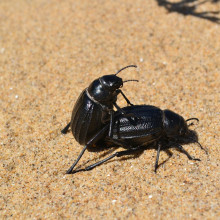
42:02 - Why do some sexual practices disgust us?
Why do some sexual practices disgust us?
with Professor Robin Mackenzie, University of Kent
As well as bodily fluids and rotting meat, there are other things people commonly 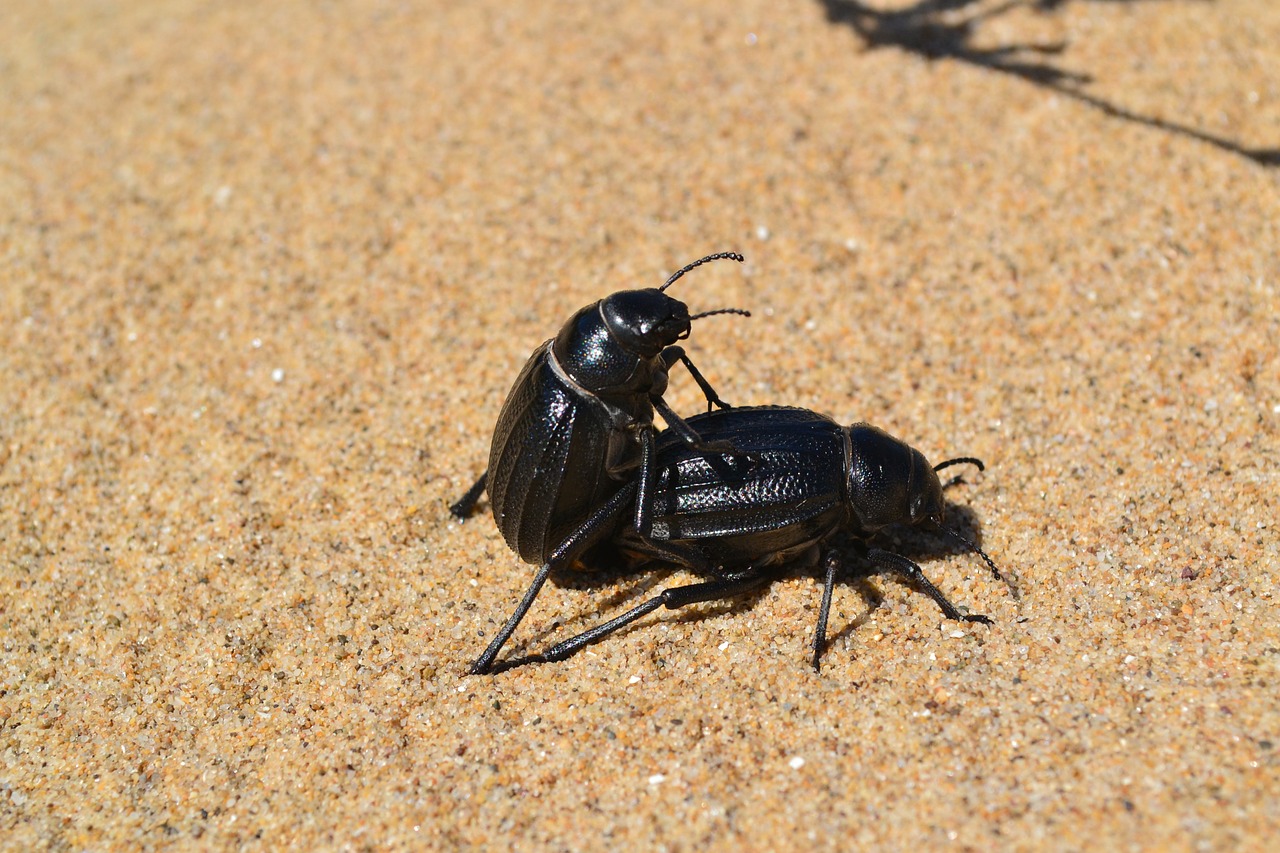 describe as disgusting, and many of them are sexual behaviours. But how do we decide what to find disgusting, and what is acceptable? Robin Mackenzie works on Neuroscience, Medical Law & Ethics at the University of Kent, and she explained to Ginny Smith what is going on in the brain when we find something disgusting.
describe as disgusting, and many of them are sexual behaviours. But how do we decide what to find disgusting, and what is acceptable? Robin Mackenzie works on Neuroscience, Medical Law & Ethics at the University of Kent, and she explained to Ginny Smith what is going on in the brain when we find something disgusting.
Robin - Well, to start with, the reaction begins in the stomach and actual body as apposed to the brain. So, you get a feeling of discomfort in your stomach. You get tense facial mask skin and you get cardiovascular changes. Your heartbeat goes either up or down. Those sensations get translated by the insular in the brain to other areas of the brain that are involved with an emotional aspect to the reaction and a cognitive reaction. In the prefrontal cortex, we will make decisions about how to deal with the emotions and how to deal with the bodily sensations by interpreting all the information from the different parts of the body.
Ginny - Why are things like sex-related behaviours so strongly linked to disgust?
Robin - Well, one of the current theories which I'm adhering to is that we were evolved to find the best possible reproductive partners that we could what this meant is that we would be in some sense, evolutionarily programmed to look out for people who seem to be healthy, who seem to be likely to be able to produce healthy children with us. So, someone who was ill, someone who was too young or too old, or in other words, unsuitable would arouse disgust to prevent us considering having sex with them as someone in the same kin group as us who was too close to have healthy children with.
Ginny - So, the idea of incest makes you feel disgusted and that's to make sure that you have healthy babies because of course, if you have a baby with someone closely related to you , they can have genetic defects.
Robin - Absolutely.
Ginny - But of course, things have changed a lot since the time we evolved in. So, how does that kind of evolutionary disgust apply in modern society?
Robin - Well, I think this is really interesting because from what Paul was saying, what happens with culture is that there's a lot of repurposing of primaly involved mechanisms. For instance, if we look at reading, reading takes advantage of things in the brain that were setup for facial recognition and object recognition, and those are put together to enable us to read and that's a form of cultural evolution. If we're looking at cultural evolution in terms of sex then with the Judeo-Christian heritage, a lot of the law and a lot of the moral ideas of what was right and wrong, were oriented around ensuring that reproduction took place as a result of sexual activity. So, things like adultery, incest, sex with animals were all seen as very much the wrong thing. Equally, having sex with someone who was menstruating was seen as a very wrong thing. Well, homosexuality and many of the kind of things that were seen as a very bad thing to do and disgusting are now increasingly seen as acceptable as society has become more secular. So, this is a form of cultural evolution.
Ginny - You work in law. What does disgust have to do with the laws that make our country safe?
Robin - Well, if you look at primate societies, there's a lot of evidence to suggest that if punishment doesn't happen to insure that conduct is appropriate in a society, then it's less likely to succeed. This gets harnessed in a form of moral disgust in our society where people think that someone who has misbehaved in a particular way or has behaved in a particular way that they conceive of as misbehaving should be punished. You can see this in terms of various sexual behaviours like paedophilia for instance. It's seen as very wrong, coercive sex and rape is seen as very wrong. So, how this impacts on our legal system is what's prohibited. And also, in terms of the sentencing and punishment, disgust comes in terms of what make the laws in that area and also, what the degree of punishment that's likely to be imposed in the sentencing has been shown to be influenced by individual's differences and in terms of how much disgust they feel.

47:10 - Talking about toilets
Talking about toilets
with Dr Alison Parker, Cranfield University
People's attitudes to what they find disgusting can change over time, and this is  something researchers are trying to harness to make the world a better place. Shockingly, there are billions of people around the world without access to adequate sanitation - in fact, more people have access to a mobile phone than to a proper toilet! Alison Parker is a Lecturer in International Water and Sanitation at Cranfield University, and she is working to tackle this problem. She told Kat Arney why people tend to try to avoid poo wherever possible...
something researchers are trying to harness to make the world a better place. Shockingly, there are billions of people around the world without access to adequate sanitation - in fact, more people have access to a mobile phone than to a proper toilet! Alison Parker is a Lecturer in International Water and Sanitation at Cranfield University, and she is working to tackle this problem. She told Kat Arney why people tend to try to avoid poo wherever possible...
Alison - I think we have a natural disgust reaction to poo because it does smell pretty bad. We're also taught that by our mothers when we're little, about washing our hands when we've used the toilet and...
Kat - Don't put your hands in the potty.
Alison - We're taught to leave the toilet in a state that someone else might want to use it afterwards.
Kat - Ideally, yes. What about other parts of the world? We heard Alex talking about cultural differences in levels of disgust. Does that same attitude persist all over the world, particularly in places maybe where they don't have such easy access to flush toilets and things like that?
Alison - I think it does. We're all naturally disgusted by faeces, but what can change is people don't understand how their faeces might end up in their drinking water. So, I had a student travel recently to India and she found that people there didn't understand that even if water looks clean, it might not be safe to drink because it might have things in it that were too small to see, but would actually make them ill.
Kat - And also, I guess in many parts of the world where they don't have access to kind of nice toilets or the kind of toilet you'd want to use, people are just doing their business anywhere I guess.
Alison - Yes. Open defecation can be quite a challenge. People go out maybe at night under the cover of darkness because they don't have anywhere to go to the toilet. This is particularly risky for women who, going out at night, face risks from rape as well as things like snake bites as well.
Kat - And so, when it comes to trying to sort out these problems, tell me about some of the ways that you and your team are trying to address the problem of people not having access to decent toilets because we're very lucky here in the west. We have lots of fresh water to flush our toilets with, lots of toilets, a toilet in every home. What are you working on?
Alison - So, we're working on a number of different technologies that will help people have access to toilets when they don't have running water, a sewer, maybe even access to power as well. So, one of the projects we're working on is called a nanomembrane toilet. This is a toilet that will work in those situations - working completely off grid to give people somewhere safe to go to the toilet.
Kat - So, how does it work? A nanomembrane toilet sounds very technologically sophisticated. Talk me through it.
Alison - So, the first stage of the nanomembrane toilet is the waterless flush. So, it's a rotating bowl with a scraper that scrapes the waste into a holding chamber below.
Kat - So, instead of it just being flushed away, like it's still vanishing from you, out of sight, out of mind kind of thing.
Alison - Yeah. It's really important in our studies with the users that they can't see or smell waste after they've produced it. So, that's a very important part of the system.
Kat - And then what happens to it? It's gone into this holding chamber. What next?
Alison - The next stage is the membrane stage. So, in the holding chamber are membranes. Membranes are like sieves. They've got really small holes in them. In fact, these holes are so small that only water molecules can pass through. So actually, water is the smallest component of human waste.
Kat - So let me get this straight. You are sieving the water out of human wee and poo, and what quality is the water that comes out?
Alison - It's actually very, very good. It would be good enough to drink.
Kat - Right. So I failed the kind of the nappy chocolate spread test. If you gave me a glass of water and said, "Okay, this has been filtered out of poo" I think I would struggle to drink that. How is this kind of technology going down with people?
Alison - So, in our initial studies in Ghana, we found that actually people were prepared to drink it, which surprised us as well. But actually, there are plenty of things that we need water for in the home that isn't drinking. So, for watering plants, for washing, lots of things that don't involve us actually consuming it and those are needs as well. So, the water can be used for that.
Kat - What parts of the world could this kind of technology be used for?
Alison - Well, anywhere where there isn't a good sewage network which in many cities in Africa and Asia, it can be, 80 per cent of the city cannot have access to a sewer. And in rural areas, that percentage is even higher.
Kat - I mean, what about here say, in the west as well because I find it crazy. I think it's something like 50 litres of fresh drinking water per person per day in the UK is just used to flush our waste away because we find it so disgusting. We're prepared to use drinking water. Could this kind of technology, do you think, be adopted here in the UK too? I mean, water is a very important resource.
Alison - Certainly, we've had a lot of interest from people who have caravans, boats or just live in remote areas where they don't have sewers so we've had a lot of interest from that. I think it's an interesting example where something that's a technology being developed for use in low income countries could actually end up being transferred back to higher income countries particularly as water stress increases.
Kat - For so long, we've had this taboo about poo. It is disgusting. No one wants to think about toilets. Maybe no one really wants to work on toilets. How exciting is it now that there suddenly seems to be interest in finding new toilet solutions?
Alison - I think it's really exciting because the disease burden from poor sanitation is just huge. Yet, no politician wants to be stood next to a toilet, having their photo taken showing that this is what they've invested in. But actually, there is a growing interest in sanitation, a growing number of people working to develop new toilets thanks a lot to the Bill and Melinda Gates Foundation who funded a huge programme in this area.
Kat - So, we need toilets for the 21st century, not for the 5th century.
Alison - Absolutely.
Kat - And just finally, what is the most disgusting toilet that you've ever had to use on your travels?
Alison - So I think, probably some of the worst ones I've seen are the public toilets in Ghana. So, some people there believe that they will get ill from squatting over the normal squat hole where people are meant to squat. So, they do their business next to the toilet and then just leave it like that for the next user. So, if you are that next user, it's pretty disgusting.

53:47 - Where are we in the Universe?
Where are we in the Universe?
Joanna Kerr asks astrophysicist Dr Sean McGee from the University of Birmingham...










Comments
Add a comment